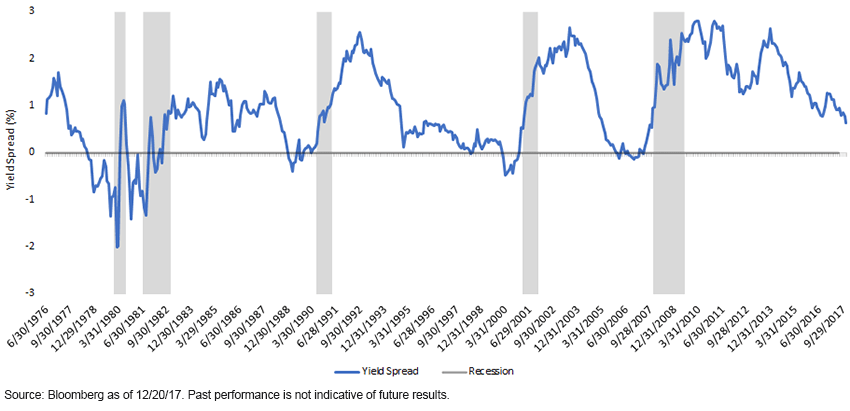In my opinion, one of the more widely discussed topics in 2018 will be the shape of the U.S. Treasury (UST) yield curve. This is a development I highlighted on a periodic basis throughout the course of 2017, and I offered our latest insights in a November 29 blog post, “U.S. Treasuries: The World Is Flat After All…At Least for the Yield Curve.”
The focus this time around will be on what, if anything, is the recent flattening of the yield curve trying to tell us? There are a variety of yield curve relationships to choose from, but perhaps one of the more closely followed for Treasuries is the 2-Year versus 10-Year maturity. While this gauge has not yet moved into inverted territory (2-Year yield > 10-Year yield), it appears as if the expectation for 2018 among bond investors is that this is where the yield curve could eventually wind up. Why is this important? Because history has shown that inverted yield curves have typically preceded recessions, and given the length of the current economic recovery, concerns have arisen as to its sustainability going forward, with any signal that a potential downturn could be on the horizon getting extra attention.
UST 2-Yr/10-Yr Spread

The general school of thought is that an inverted yield curve indicates a pending recession in about a year’s time. It certainly is not a perfect science in this regard, but it has definitely served as a rather useful predictive tool, as I mentioned above. In fact, over the last 40 years, the only time an inverted UST 2/10 spread did not “predict” a recession roughly 12 months out was in 1998: The spread went into negative territory around midyear 1998, but according to the National Bureau of Economic Research (NBER), the unofficial keeper of business cycles, the subsequent downturn didn’t begin until Q1 2001. According to a report from the Federal Reserve (Fed) of Cleveland, utilizing the UST three-month t-bill versus the UST 10-Year note spread, it estimated “the expected chance of the economy being in a recession next October at 11.8 percent” and stated, “the yield curve is optimistic about the recovery continuing, even if it is somewhat pessimistic with regard to the pace of growth over the next year.”1













Leave A Comment